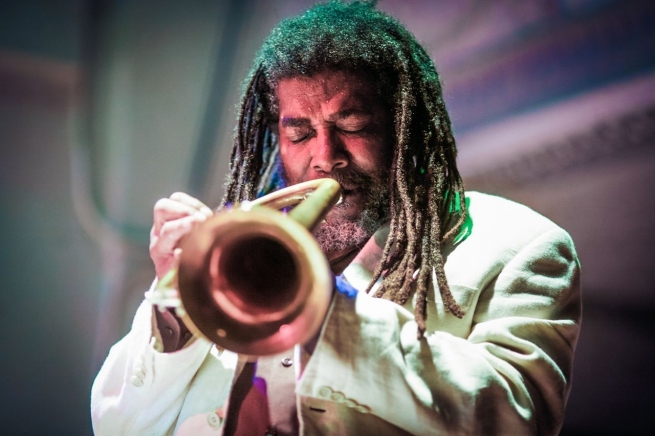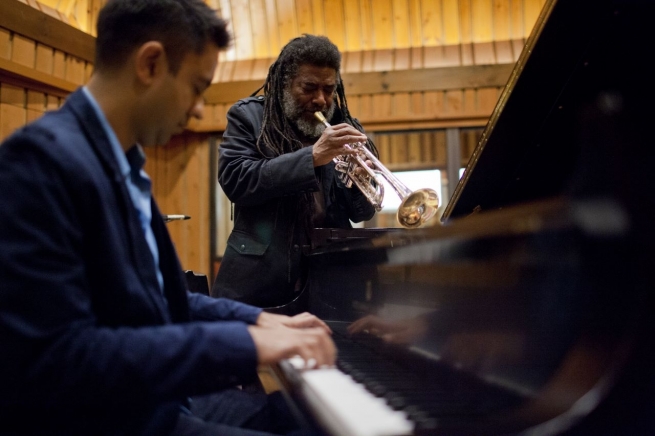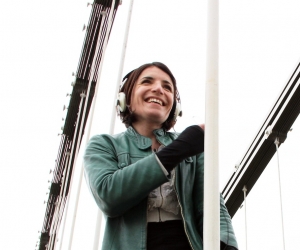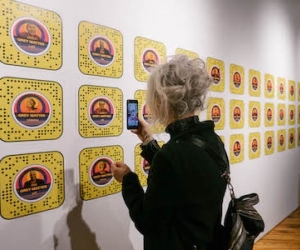
Think of this as a sketch.
We’re not going to get into a complete report on the doings of Wadada Leo Smith here, his more than fifty recordings, his dozens of collaborations with luminaries from all over the globe, his long engagement with creative music. No, we’re merely orbiting the beautiful planet that is his life’s work, listening to transmissions and deciphering their codes as best we can, collating input from other observers, and talking on the phone with the man himself about what drives his art—which, as it turns out, is a kind of resonant humanism, expressed through genuine personal warmth.
So let’s first talk about that. Before getting into his Ankhrasmation system of composition, his pedagogical innovations, his relationship with the trumpet, or his musical tributes to musical heroes, Great Lakes, civil-rights icons, and endangered parkland, let’s ask Wadada if his life’s project is fundamentally an exercise in radical inclusivity.
“You know, I don’t really like the word radical, because things that are really radical, like radical spiritual evolution, stuff like that, those are normal stuff, and everything else is behind the normal stuff,” he cautions gently from his home in New Haven, Connecticut. “Radical is like the real stuff. And the stuff that’s behind that—that’s not radical—is actually kind of an illusion of the real stuff. But what I do think about is that making art, in itself, is one of those authentic, real events, and that gives us the possibility of dreaming of what could be the magnificent something that we should all be into—or be about.”
Leo Smith—Wadada came later, and derives from an Amharic greeting that’s as sweet and layered as the Hawaiian aloha—was born in Leland, Mississippi, in 1941. In a culture that respected music, he soon had a trumpet in his hands, and not long after that he began to develop the clarion approach that marks his music to this day. When he plays, you listen.
“As you’ve noticed, almost every spiritual tradition refers to the sounding of the trumpet or the pealing of brass, which is the same thing as the trumpet,” Wadada says. “The trumpet is kind of a metallic horn, except in Africa they’re made out of ivory. Now, the trumpet is a unique instrument. It’s a conical tube that’s been bent a couple of ways, and that then allows the [blowing] of air through a tiny little hole that creates a tremendous back pressure on the individual that’s playing it. That has to be controlled in a way that not too much and not too little comes through to produce the sound. And the physicality of the sound is produced in the abdominal section, straight on through to the physical sending of a projectile of, like, air through that little hole. And therefore what do we have? We have a dynamic, responsive energy that needs to be implemented in small doses by a continuous stream.”
Playing trumpet is a kind of breath yoga, I suggest.
“Yeah. That’s why wind instruments are so important. They transform you while you’re playing them.”

In Mississippi culture, not only those who could sound the trumpet were transformed.
Pianist Vijay Iyer (photo above), a frequent Smith collaborator—who can be heard on several of the trumpeter’s Golden Quartet and Quintet recordings, as well as on an extraordinary, mostly improvised duet, A Cosmic Rhythm With Each Stroke (2016, ECM)—relays an anecdote that his mentor passed on. “He comes from this really profound musical . . . we could call it a tradition, but that sort of makes it seem fixed and closed,” Iyer says, choosing his words carefully and with obvious respect. “Really, what it is is this kind of historical flow that’s called the blues. You know, he started playing trumpet when he was eleven or something like that, and he said that part of his coming of age was when someone would move into a new house, he had to come in and blow the spirits away. So he had this almost shamanistic role already thrust upon him from an early age. It was like being a channel or a conduit or a sort of catalyst to move energy around. And that’s really what the blues tradition or lineage or sensibility is about—summoning that energy. And it’s something ancient. There’s something almost terrifying in its power, sometimes, but also something magnificent and beautiful, of course.”
In recent years, Smith has also taken on another ancient African duty: that of the griot. Dispenser of deserved praise, holder of oral history, and musical improviser, the griot in West Africa is responsible for maintaining a sense of cultural continuity within his—or, more recently, her—community, and that’s more or less exactly what Wadada has been doing with albums like the four-disc Ten Freedom Summers (2012, Cuneiform), the two-disc The Great Lakes Suites (2014, TUM), the two-disc America’s National Parks (2016, Cuneiform) and the two-disc Occupy the World (2013, TUM). Some of these paint nonverbal portraits of places and people he’s loved, ranging from his mother (Sarah Bell Wallace), to musical colleagues (pioneering saxophonist Marion Brown, Art Ensemble of Chicago bassist Malachi Favors Maghostut), to real and imagined places of endangered beauty and uplift (the five Great Lakes, Yellowstone, Yosemite, and the “national culture park” otherwise known as New Orleans). Others, like his newly released Rosa Parks: Pure Love (2019, TUM), are more explicitly songs of praise, extended oratorios illuminating exemplars of courage.
“What I do is I have what I call a psychological reading of the space, the space being the object of my interest, whether it be part of an individual or a thing—like, say, the [U.S.] Constitution,” Wadada says. “I look to see what the psychological expression that these particular things, in their space, represent, and that’s what I go after. I don’t go after—like with the Rosa Parks oratorio, or the Rosa Parks piece that’s in 10 Freedom Summers—I don’t go after a biographical representation of her, or look at what she did and make that the object of interest. I go into the psychological profile of her, and try to find the meaning behind events through her psyche. And how do I do that? I do it through reflection, my own quiet moments of reflecting; I do it though research; that is, I try to find everything that I can on the person, place, or thing, and read it. Then I work through it for days, weeks, or months by just jotting stuff down in my notebooks. And eventually, when I feel like I’ve covered enough information, I sit down with that notebook, my memory, my sensations or feelings, and I start to write.”
The process can be collaborative. A Cosmic Rhythm With Each Stroke began when Iyer introduced Smith to the Pakistani painter Nasreen Mohamedi, finding in her images—and in her determination to do unique and deeply personal work under less than ideal circumstances—some striking parallels to Smith’s own practice.
“It was partly an homage to somebody, which as you know Wadada’s done many times on his own records,” Iyer says. “And that sort of means a certain kind of willingness to submit to the identity and the logic and the mystery of someone else’s work—and not presume to capture or depict it exactly, but really kind of meet it, artist to artist. What happens when the two of us look at something else that has its own power, its own resonance, its own majesty, and its own haunting spirituality? What does this bring out for the two of us? That’s basically what the process was. It wasn’t so much like ‘Okay, let’s do this drawing. It’s a score, so let’s say ‘vertical’ is pitch and ‘horizontal’ is time and so on.’ No, it wasn’t that at all.
“Instead, it drew something out of us that was beyond any kind of literal mapping of what we were seeing,” he continues. “There’s something beneath or beyond what’s on these pieces of paper that’s animating us—and then we really just surrendered to intuition for a lot of it. All that music just emerged fully formed in the process of recording. There’s a piece on there, ‘The Empty Mind Recedes,’ that wasn’t even the first piece we did: it was our soundcheck. That day in the studio we’d set up, and I was warming up, and [ECM label owner-producer] Manfred Eicher was in the booth and he comes on the intercom and says ‘Could you please make some sound together, so we hear what this music sounds like?’ And in that moment, we just made that piece. It just came through us in a way that I could’t even explain.
“It was almost like it came to us in a trance or something, and the whole day sort of proceeded that way.”

Okay, if you've gotten this far you're probably owed a confession.
I’m not quite the dispassionate observer of Wadada Leo Smith I’ve been pretending to be. It’s true that I’ve only met the trumpeter once, and that was forty years ago—but nonetheless, through the miracle of file sharing, I’ve made a record with him.
Some years ago (perhaps as therapy—I was just emerging from a devastating divorce) our mutual friend Henry Kaiser invited me to make a two-guitar version of Wadada’s Pacifica Coral Reef with him. (Henry and Wadada jointly lead Yo, Miles!, a punchy and very amplified tribute to Miles Davis’s electric period.) The score itself is beautiful (see image above), a vision in tropical aquamarine and gold, with some loose notation suggesting intervallic relationships but not specific notes or time values, and we spent more time absorbing it than discussing it. Along the way, some loose conceptual devices emerged. One passage was built around slowly arpeggiated six-note chords, à la Morton Feldman; in another, we each attempted to conjure a favourite blues guitarist, Pete Cosey for Henry and Hubert Sumlin for me; a third episode resembles a highly abstract take on Baroque polyphony.
There were moments, we both agreed, where we’d invented sounds we’d never envisioned before, while at other points we each sounded very much like ourselves. And when Henry sent it to Wadada for comment, he liked it so much that he asked to overdub some trumpet parts, which only improved matters. The finished record, which has not yet been released, is without a doubt the highlight of my life as a performer.
Not all of Smith’s scores are quite as open-ended as Pacifica Coral Reef, but all allow the performer considerable agency. “Much of his music is notated, but not necessarily with a specific tempo or time signature,” says cellist Ashley Walters, who has performed extensively and in a variety of contexts with Smith. “‘Black notes’ are short notes and ‘white notes’ are long notes (a nod to classical notation), but it is up to the performer to determine what long and short mean to her. The scores require study and experimentation, and because of the notation, every performance is different. I appreciate this and I love that Wadada’s music is not rigid. It allows you to reflect on the present time, space, and emotions.”
“There’s more detail in the music than people might assume,” Iyer comments. “If you have a certain kind of clichéd set of assumptions about what improvisation sounds like, then you might not realize how much of it is actually in the score. Like, I would have parts that were just sort of isolated, but they were clearly written out to play. And then when I play a recording of it and say ‘See that right there? that’s in the score,’ people wouldn’t believe me. They’d be incredulous, like ‘How could that be in the score?’ First of all, it sounds like it was my idea—and that’s something magical that happens with it, that it can be embodied in such a way that you have to kind of make it yours. But also it seems to emerge from this totality in a way that wouldn’t necessarily identify it as this planned moment that’s supposed to happen. It just feels like it happened.”
Smith himself calls his musical system Ankhrasmation, a portmanteau term etymologically derived from ancient Egyptian, Ethiopian, and European sources. One way to interpret the concept would be to say that it involves the ability to decipher glyphs, master one’s instrument, and keep a flexible mind. (The ankh, in Egyptian hieroglyphics, symbolizes life; ras, in Amharic, signifies either a secular or a spiritual leader, or someone who combines both qualities; mation comes from animationem, a Latin term meaning “the action of imparting life”.) Another way of putting it would be to say that, in his work, language, imagery, and sound are indivisible.
“I do see it as this larger view of what is possible in creation,” Smith says. “If you look at the Ankhrasmation scores, for example, they’re language scores—and by language I mean a fairly specific set of images that are connected directly with how you use them. And then there’s another dimension, which is totally reflective and, ah, kind of cognitive/emotive, which is the colour and stuff like that. So when I think about, How do these things connect, and what do they mean for us as people? they kind of give us the opportunity to not only view the score, understand the score, and perform the score, they allow us to kind of reach a level—not just artistically, but a human level—of true communication. And therefore if it’s true communication, then the score itself at the end of the execution becomes obsolete for that moment. And the event created becomes the great horizon of something that’s been manifested through a group effort.”
That brings us back to the notion of Wadada as shaman or conduit:
a vehicle through which musicians and listeners, individually and collectively, can manifest our best selves. Henry and I are hardly alone in having that experience.
“Wadada sees every musician as a unique artist with his or her own voice,” says Walters (photo, right). “When [bassist] John Lindberg was unable to perform a concert, Wadada called me to fill in with the Golden Quartet, performing the quartet version of Ten Freedom Summers. My experience, up until that point, had been playing the cello part in the full version of the piece and I was now playing the bass part. In a conversation I had with Wadada, he said that he didn’t expect me to improvise the way John does or to play phrases exactly as he does. He said that he was asking me to play as I do: to improvise as I choose, to play as a cellist, and to be myself. What a generous thing to say to a performer!
“I believe that Wadada’s music, while complex, can be understood by musicians of various backgrounds,” she continues. “That isn’t to say that it doesn’t require intense focus, study, research, and practice. I feel that greater understanding of Wadada’s notation allows greater experimentation with sounds and colours, and he welcomes interpretation by the performer once she has mastered the score.”
“Basically how he operates is that he finds a way to hear a person’s humanity and reach out to them on that basis and create something that’s born, genuinely, of that relationship,” says Iyer, citing Wadada’s own ability to make music at a high level with string quartets, large jazz ensembles, reggae musicians, Zimbabwean chimurenga legend Thomas Mapfumo, and Asian string virtuosos. “He’s also this incredible, visionary composer. But, inside of that, the premise is basically that anyone can make music together if they really listen, if they really approach it with respect and sincerity. Whatever we don’t have in common is eclipsed by that, you know.
“He inspires us all to both reach higher and to go deeper.”
That’s a sentiment Walters agrees with—and she cites an instance in her own life where her collaboration with her “musical hero and mentor” has spilled over into her personal life, in a particularly joyous way. “Wadada is one of the most generous people I know, and I think that is revealed in his music,” she says. “When I got married, Wadada played at our wedding, playing unique music for each person that entered the garden during the ceremony. His spirit and his works emote love, and I couldn’t think of a better person to welcome my husband and I into our marriage.”
Wadada Leo Smith’s music might exist in the most elevated of cosmic spheres, but art doesn’t get much more down-to-earth than his.
Audio: Pacifica Coral Reef, composed and performed by Wadada Leo Smith (trumpet, piano). Recorded at Fire House 12, New Haven, Connecticut, in 2018 by engineer Nick Lord.
Top photo of Wadada Leo Smith by Michael Jackson. Photo with Vijay Iyers by John Rogers / ECM Records. Photo with Ashley Walters by Luke Storm.
More information about Wadada Leo Smith here.

